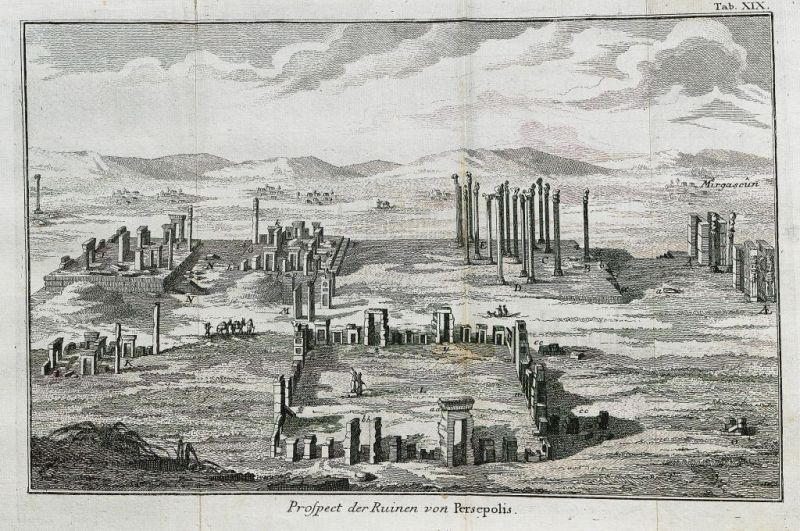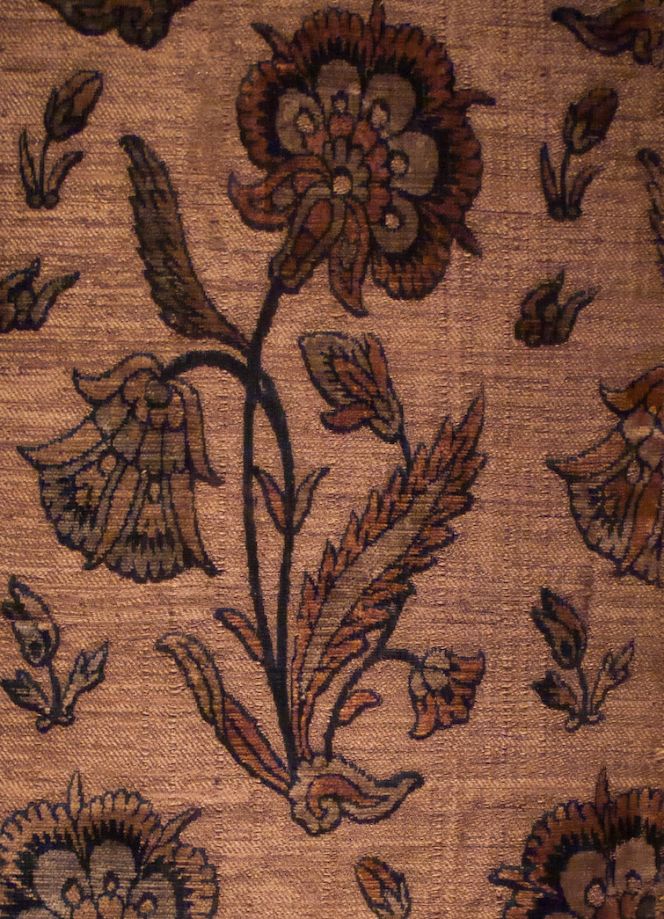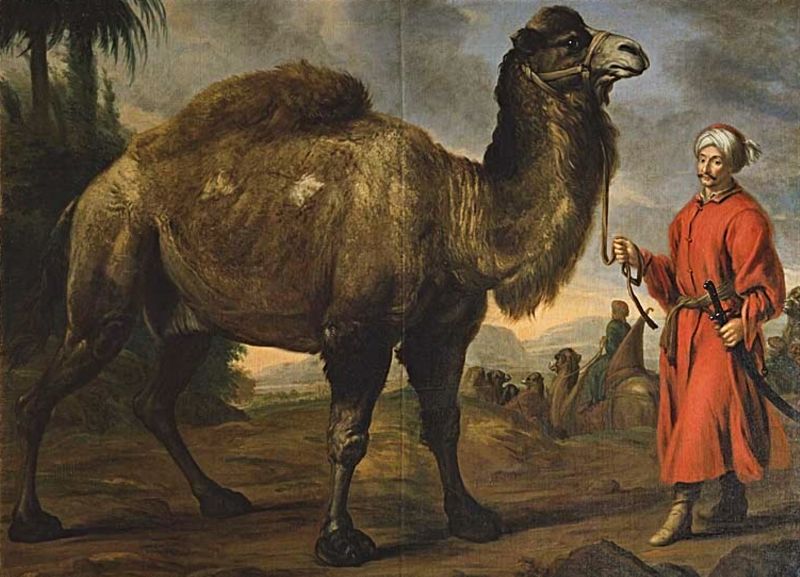ikfoundation.org
The IK Foundation
Promoting Natural & Cultural History
Since 1988


 Crowdfunding Campaign
Crowdfunding Campaignkeep knowledge open, connected, and growing on this textile history resource...
CARSTEN NIEBUHR’S TEXTILE OBSERVATIONS
– in Persia, Syria and the Arabian Peninsula: 1765-1766
Historical clothing from an 18th century perspective, long-lasting trade in precious silk fabric and raw silk, and weaving of carpets and cotton cloth alike will be the focus of this second essay in a series of three. At a time when the cartographer Carsten Niebuhr (1733-1815) travelled via Persia, Syria and the Arabian Peninsula with the ‘Royal Danish Expedition to Arabia’. He recorded traditions that had lasted for many centuries, in some places more than two thousand years, along the wide-stretching caravan routes – first named the Silk Road about 100 years after his journey. In this context of ancient trade, Niebuhr also noticed the relatively recent involvement of several European East India Companies. Companies that are primarily associated with trade via long sea voyages, but connecting transports via camel caravans over land were an essential part of this lucrative business.
![When travelling from India to Muscat on the southeastern coast of the Arabian Peninsula, Carsten Niebuhr on the 2nd and 3rd of January in 1765 added some notes about his own clothes in the travel journal. ‘We often had storm and rain, and due to that I lacked winter clothes (I had once again started to use European clothing in Bombay [today Mumbai]), I was very sensitive to the cold weather. In the afternoon we had a good wind, so we finally reached the harbour in Muscat on 3rd January’. This map of Muscat – included in his journal – clearly demonstrates the sheltered position of the old trading town. (From: Niebuhr…1778. Vol. Two. Tab. XV).](https://www.ikfoundation.org/uploads/image/1-niebuhr-2-tab-xv-664x885.jpg) When travelling from India to Muscat on the southeastern coast of the Arabian Peninsula, Carsten Niebuhr on the 2nd and 3rd of January in 1765 added some notes about his own clothes in the travel journal. ‘We often had storm and rain, and due to that I lacked winter clothes (I had once again started to use European clothing in Bombay [today Mumbai]), I was very sensitive to the cold weather. In the afternoon we had a good wind, so we finally reached the harbour in Muscat on 3rd January’. This map of Muscat – included in his journal – clearly demonstrates the sheltered position of the old trading town. (From: Niebuhr…1778. Vol. Two. Tab. XV).
When travelling from India to Muscat on the southeastern coast of the Arabian Peninsula, Carsten Niebuhr on the 2nd and 3rd of January in 1765 added some notes about his own clothes in the travel journal. ‘We often had storm and rain, and due to that I lacked winter clothes (I had once again started to use European clothing in Bombay [today Mumbai]), I was very sensitive to the cold weather. In the afternoon we had a good wind, so we finally reached the harbour in Muscat on 3rd January’. This map of Muscat – included in his journal – clearly demonstrates the sheltered position of the old trading town. (From: Niebuhr…1778. Vol. Two. Tab. XV).From the trading port Bushehr in Persia, in February 1765, he described the importance of the textile trade among other wares:
- The English send a lot of European canvas to this port, as well as many Indian goods from Surat and Bengal. The articles which are sent from here are exquisite: silk fabrics from Jezd and Kaschan, raw silk from Ghilan, carpets (the most expensive comes from Isfahan), fine wool or goat's hair from Kerman ... Further cotton, all sorts of beautiful fruit from the mountainous area, rose water and a large amount of wine from Shiraz. Regarding several of these articles, the English East India Company does not concern itself. They are part of Mr. Jervis’ private trade, who simply leads his own business on behalf of a young merchant in Shiraz. Goods which are transported further on horses and mules from Persia to East India.’
![During the stay in Shiraz during April 1765, Niebuhr made notes on the style and garments included in Persian dress, studied from people he met in the streets. He also made comparison to some depicted individuals on stone carvings in the ancient ceremonial capital of Persepolis [today in Iran] – which was visited in the previous month when he had made a very extended annotation of the same. This plate is one of several examples in Niebuhr’s travel journal, which illustrate carvings dated to circa fifth century BC. (From: Niebuhr…1778. Vol. Two. Tab. XVIII).](https://www.ikfoundation.org/uploads/image/2-niebuhr-2-tab-xxii-800x509.jpg) During the stay in Shiraz during April 1765, Niebuhr made notes on the style and garments included in Persian dress, studied from people he met in the streets. He also made comparison to some depicted individuals on stone carvings in the ancient ceremonial capital of Persepolis [today in Iran] – which was visited in the previous month when he had made a very extended annotation of the same. This plate is one of several examples in Niebuhr’s travel journal, which illustrate carvings dated to circa fifth century BC. (From: Niebuhr…1778. Vol. Two. Tab. XVIII).
During the stay in Shiraz during April 1765, Niebuhr made notes on the style and garments included in Persian dress, studied from people he met in the streets. He also made comparison to some depicted individuals on stone carvings in the ancient ceremonial capital of Persepolis [today in Iran] – which was visited in the previous month when he had made a very extended annotation of the same. This plate is one of several examples in Niebuhr’s travel journal, which illustrate carvings dated to circa fifth century BC. (From: Niebuhr…1778. Vol. Two. Tab. XVIII). On the way to Persepolis in February 1765, Niebuhr once more made a note about his own clothes. ‘I still retained my European dress from India on the journey to Persepolis, but also experienced all the inconveniences associated with short and narrow clothes on caravan travels.’ (From: Niebuhr…1778. Vol. Two. Tab. XIX).
On the way to Persepolis in February 1765, Niebuhr once more made a note about his own clothes. ‘I still retained my European dress from India on the journey to Persepolis, but also experienced all the inconveniences associated with short and narrow clothes on caravan travels.’ (From: Niebuhr…1778. Vol. Two. Tab. XIX).A bit further on during the journey, he came close to local textile traditions and the Beduin families’ everyday lives. For instance, women worked with wool, and according to his opinion, the carpets were of good quality, but not as fine as in the Persian villages. However, he thought that the wool was beautifully dyed, but his journal included no details about which plants or insects the dyers traditionally used.
 In general regarding textile material, Niebuhr most frequently showed an interest in cotton, woollen and silk useful for everyday clothes. But he also briefly noticed fine silk fabrics and carpets in connection to trade within Persia (noted above), however without any specific observations on motifs, colours or techniques. This beautiful velvet fragment of silk, cotton and metal threads spun around a silk core, may stand as a comparable example to Niebuhr’s experience of the most exquisite qualities existing in the area and which had been produced in Persia (Iran) for centuries at the time of his visit in 1765. (Collection: Islamic Art Exhibition, no. 8/1986, early 17th century. The David Collection, Copenhagen, Denmark). Photo: Viveka Hansen, The IK Foundation.
In general regarding textile material, Niebuhr most frequently showed an interest in cotton, woollen and silk useful for everyday clothes. But he also briefly noticed fine silk fabrics and carpets in connection to trade within Persia (noted above), however without any specific observations on motifs, colours or techniques. This beautiful velvet fragment of silk, cotton and metal threads spun around a silk core, may stand as a comparable example to Niebuhr’s experience of the most exquisite qualities existing in the area and which had been produced in Persia (Iran) for centuries at the time of his visit in 1765. (Collection: Islamic Art Exhibition, no. 8/1986, early 17th century. The David Collection, Copenhagen, Denmark). Photo: Viveka Hansen, The IK Foundation.It is noticeable that Niebuhr, off and on, had problems with his European-style clothes, but at this time, it was for another reason compared to his experiences when travelling. In Shiraz, April 1765, he wrote. ‘Since I was dressed in European clothing in Persia, I could not walk around everywhere in Shiraz like in the other Muslim towns, and therefore I could not draw an accurate view of this town.’ It may be assumed that despite his frequent inconveniences, he did not attempt to use local dress or maybe he could not afford to purchase such cloth on this stretch of the journey.
Occasionally, during his travels leading to Basra, Bagdad and Mosul, a few lines about local clothing appear, even if such notes seem to have been less important for him. The focus in the extensive travel writings was above all: religion, language, geography, political structures in the present as well as in the past, the complex cooperation or hostilities between various groups, dangers during travel, health and illnesses, food, drink and European individuals he met during the journey.
 To travel under the protection and security of a caravan was mentioned at more than one occasion in his very detailed journal, for this stretch of the journey; Bushehr, Shiraz, Persepolis, Basra, Bagdad, Mosul, Diyarbakir to Aleppo. Just like on the continuing travel to Constantinople and other cities in this geographical area. Even if seen from the eyes of a Nordic artist with some romanticisation, this depiction of ‘camel with driver’ gives an understanding of the warm clothes used by merchants along the caravan routes over wide-stretching geographical areas. Trading traditions which had existed in various forms for more than two thousand years during the time of Niebuhr’s travel. Oil on canvas by David Klöcker Ehrenstrahl (1628-1698). (Courtesy: National Museum, Stockholm, Sweden. NMDrh 9).
To travel under the protection and security of a caravan was mentioned at more than one occasion in his very detailed journal, for this stretch of the journey; Bushehr, Shiraz, Persepolis, Basra, Bagdad, Mosul, Diyarbakir to Aleppo. Just like on the continuing travel to Constantinople and other cities in this geographical area. Even if seen from the eyes of a Nordic artist with some romanticisation, this depiction of ‘camel with driver’ gives an understanding of the warm clothes used by merchants along the caravan routes over wide-stretching geographical areas. Trading traditions which had existed in various forms for more than two thousand years during the time of Niebuhr’s travel. Oil on canvas by David Klöcker Ehrenstrahl (1628-1698). (Courtesy: National Museum, Stockholm, Sweden. NMDrh 9).Textile observations with connections to the caravan routes and camel loads continued during his journey. A few concluding quotes will give some idea of the amount of goods transported and the many aspects taken into account within this trade. From Mosul in March 1766, for instance: ‘In Mosul, I had to bring my stuff to the Customs Chamber, but paid nothing more than some tips to the staff so they could expedite me quickly. The merchants pay 10 piastre for a camel load of canvas or silk clothing ... If the goods arrive on donkeys or mules, they will be weighed and paid in proportion to the aforementioned.’ Whilst Niebuhr during the travel from Mosul to Mardin in April of the same year, noted: ‘In our caravan there were at least 2.000 loads, 1.300 camels were loaded with oak galls/oak apples from Kurdistan, 120 camels with all sorts of canvas from India, Persia, Baghdad and Mosul, and 45 camels with coffee beans…’
The caravan, which Niebuhr was part of, also passed through villages, where he noted that the farming communities had a substantial production of woven cotton cloths. On this stretch, like on many other routes, possibilities arose for the merchants to buy more cloth on the travel route itself, which later on in towns and villages along the caravan route could be sold to presumptive costumers.
Notice: Quotes have been translated for this essay by Viveka Hansen – from Danish to English from (Niebuhr…2003), if not otherwise stated. This is the second essay of three about Carsten Niebuhr’s textile observations from 1761 to 1767.
Sources:
- Baack, L.J., Undying Curiosity – Carsten Niebuhr and The Royal Expedition to Arabia (1761-1767), Stuttgart 2014.
- Hansen, Viveka, Textilia Linnaeana – Global 18th Century Textile Traditions & Trade, London 2017.
- Niebuhr, Carsten. Reisebeschreibung nach Arabien und andern umliegender Ländern. Volume Two. Copenhagen, 1778.
- Niebuhr, Carsten, Rejsebeskrivelse fra Arabien og andre omkringliggende lande (Intr., Michael Harbsmeier), København 2003 (Volume Two, pp. 94-447).
- The David Collection, København, Denmark. [Textiles from Persia (Iran), a study visit in 2019].
More in Books & Art:
Essays
The iTEXTILIS is a division of The IK Workshop Society – a global and unique forum for all those interested in Natural & Cultural History.
Open Access Essays by Textile Historian Viveka Hansen
Textile historian Viveka Hansen offers a collection of open-access essays, published under Creative Commons licenses and freely available to all. These essays weave together her latest research, previously published monographs, and earlier projects dating back to the late 1980s. Some essays include rare archival material — originally published in other languages — now translated into English for the first time. These texts reveal little-known aspects of textile history, previously accessible mainly to audiences in Northern Europe. Hansen’s work spans a rich range of topics: the global textile trade, material culture, cloth manufacturing, fashion history, natural dyeing techniques, and the fascinating world of early travelling naturalists — notably the “Linnaean network” — all examined through a global historical lens.
Help secure the future of open access at iTEXTILIS essays! Your donation will keep knowledge open, connected, and growing on this textile history resource.
been copied to your clipboard




– a truly European organisation since 1988
Legal issues | Forget me | and much more...
You are welcome to use the information and knowledge from
The IK Workshop Society, as long as you follow a few simple rules.
LEARN MORE & I AGREE







